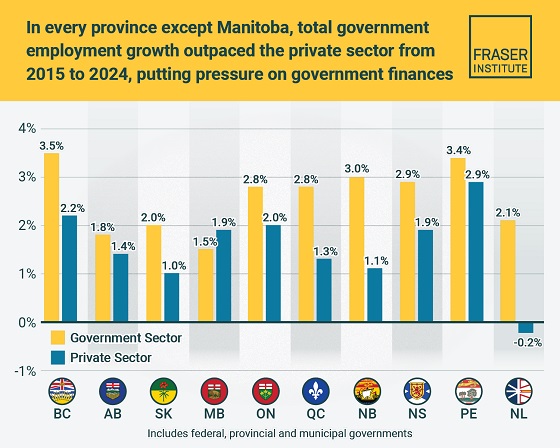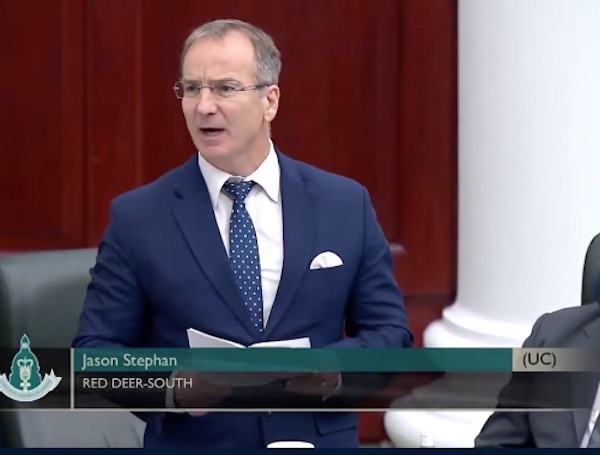Business
There are smart ways to diversify our exports

From the Fraser Institute
By Philip Cross
The Bank of Canada recently cut interest rates again, with further cuts likely in response to Donald Trump’s threat to impose tariffs on Canadian exports. This continues the Bank’s reflexive turn to lower interest rates to goose growth every time the economy slows that began during the 2008 global financial crisis and reached its apex during the outbreak of the Covid pandemic when rates essentially hit their zero lower bound.
It’s time policymakers in Ottawa stop relying on easy money policies in response to every hiccup in economic growth. Lower interest rates have introduced major distortions into Canada’s economy. They have fueled excessive debt levels in all sectors of the economy, helped to create a housing bubble that will depress growth when it bursts, undermined our consensus on the usefulness of immigration when excessive demand raised the cost of shelter, and led youths to lose hope of achieving the dream of owning a home. Housing’s unsustainably large share of our economy helps undermine our potential productivity, the lack of which Bank of Canada Deputy Governor Carolyn Rogers last year called a “break the glass” emergency. However, the Bank’s own easy money policies spurs the shift of more resources to housing and encourage governments to ignore taking actions that would boost business investment and exports, the two sectors needed to improve our long-term productivity and competitiveness.
There are policy alternatives to just mechanically lowering interest rates and juicing housing demand. The silver lining in Trump’s tariff threats is they drive home to Canadians the twin follies of not diversifying our energy exports from the U.S. market and not lowering internal barriers to trade among our provinces. We witlessly ignored opportunities to move on both fronts for nearly a decade after Trump fired his opening salvo in the trade war with punitive tariffs on our aluminum and steel industries in 2017.
Energy, our leading export, depends on the U.S. market for 93 per cent of its export earnings. Canada has wasted numerous opportunities over the past decade to open overseas markets for oil and gas. The Trudeau government cancelled the Northern Gateway pipeline that would have sent Alberta crude to Asia. The proposed Energy East pipeline to send oil to New Brunswick and ultimately Europe floundered after the federal government complicated the approval process. Multiple proposals for LNG projects were rejected, although the Quebec government is reconsidering its opposition to ship natural gas from an LNG terminal in Saguenay to Europe. Quebec is not reflexively against pipelines: its former Premier Jean Charest boasts how his government oversaw one connecting crude oil imports landing at Levis to refineries in Montreal by clearly outlining the benefits to Quebecers. Restricting our oil and gas exports to the U.S. has depressed their prices, costing Canada tens of billions of dollars of lost revenue and betraying our European allies when they desperately needed alternatives to Russian natural gas supplies following its attack on Ukraine.
Meanwhile, the federal government displayed little leadership in trying to get the provinces to reduce the thicket of regulations and restrictions that impair trade within Canada. The 2017 Canada Free Trade Agreement provided a road map to potentially lower internal trade barriers, but most provinces have been reluctant to tread that path. It is the height of hypocrisy for Canadians to complain about Trump’s threatened tariffs when we tolerate internal trade barriers that are every bit as important and costly to our economy. Statistics Canada, for example, found that trade within Canada moves as if there were a 7 per cent tariff on goods moving between provinces, while trade within the U.S. flows as if there was no effective tariff.
The shock and outrage Canadians are expressing about Trump’s pending 25 per cent tariff on most exports can be channeled to our benefit. Achieving that will require governments to stop our dangerous over-reliance on low interest rates to stimulate housing. Instead, the focus should be improving our access to markets outside the U.S., which are clearly viable and profitable for goods such as oil and gas. Furthermore, if we truly believe our own rhetoric about the benefits of trade, we need to take concrete steps to liberalize trade within Canada.
Business
Is affirming existing, approved projects truly the best we can do in Canada?

From Resource Works
For major projects, what is old is new again
Prime Minister Mark Carney’s second wave of “nation-building projects” sounds transformative: six new energy and mining proposals, plus a northern corridor, added to the first tranche unveiled in September, and included in the freshly passed federal budget for the fiscal year.
Together, Ottawa says, they amount to more than $116 billion in investment and are central to “realizing Canada’s full potential as an energy superpower.” That is the pitch in the federal news release.
Look closely, though, and a different picture emerges. For major projects, what is old is new again. Almost every file now being “fast-tracked” was already on the books, sometimes for a decade or more.
The new referrals to the Major Projects Office (MPO) are all familiar: the Nisga’a-led Ksi Lisims LNG terminal on B.C.’s north coast; BC Hydro’s North Coast Transmission Line; Canada Nickel’s Crawford project near Timmins; Nouveau Monde Graphite’s Matawinie mine north of Montréal; Northcliff’s Sisson tungsten project in New Brunswick; and the Inuit-owned Iqaluit Nukkiksautiit hydro project in Nunavut. The “Northwest Critical Conservation Corridor” in B.C. and the Yukon is added as a long-range concept.
Long timelines and longstanding obstacles
None of these is a fresh idea. As the Globe and Mail notes in a project-by-project rundown, Ksi Lisims has been in development for years and already faces two Federal Court challenges from nearby First Nations and opposition from Wet’suwet’en hereditary leaders who fought Coastal GasLink. The North Coast Transmission Line was identified in 2023, with B.C. legislation to fast-track it and term-sheet co-ownership deals with First Nations already in place. The Sisson mine has been stalled at the pre-construction stage for more than a decade, despite earlier approvals and new public money to update its feasibility study.
Iqaluit hydro is hardly a novelty either. As Globe reporting shows, dam concepts near the city have been studied since the mid-2000s, with the current Inuit-owned proposal building on that earlier work and backed by federal engineering funds. The Crawford nickel project was acquired in 2019 and has spent years lining up investors and a complex financing stack, documented in both CBC and Financial Post coverage. Matawinie received its Quebec authorization in 2021, has an impact-benefit agreement with the local Atikamekw Nation and now enjoys federal price-floor guarantees on graphite.
The first tranche, announced in September, follows the same pattern. LNG Canada Phase 2 in Kitimat, new nuclear at Darlington, Contrecoeur container capacity at the Port of Montréal, McIlvenna Bay in Saskatchewan and the Red Chris expansion in B.C. were all in various stages of planning long before Carney entered office. The MPO is not inventing a new project pipeline; it is trying to accelerate the one Ottawa already had.
Acceleration is the point — and industry welcomes it
Acceleration is, to be fair, the point. The Calgary-based MPO, led by former Trans Mountain head Dawn Farrell, is designed to run permits in parallel, not one after another, and to coordinate financing through bodies like the Canada Infrastructure Bank and Canada Growth Fund. Farrell told CBC that work which might have taken “five or six more years” could be cut to roughly two. In a country where large projects regularly die of regulatory exhaustion, that is significant.
Industry likes the signal. Canada Nickel CEO Mark Selby says MPO referral “puts us in the fast lane,” even without the more controversial “national interest” label in Bill C-5 that would allow cabinet to set aside parts of the Fisheries Act, Species at Risk Act or Impact Assessment Act. Inuit proponents of the Iqaluit project welcome Carney’s description of their hydro plan as a breakthrough for Arctic sovereignty, replacing millions of litres of diesel.
But a superpower strategy this is not
Still, if this is what becoming an “energy superpower” looks like, it is a modest start.
Notably absent from Carney’s list is any new oil pipeline. Alberta Premier Danielle Smith has spent months pushing a concept for a bitumen pipeline from the oil sands to the northern B.C. coast, doing provincial groundwork in the hope a private proponent will one day take it over. A BBC report sets out the feud with B.C. Premier David Eby, who dismisses the idea as “fictional” and “political” and insists no company wants it, accusing Smith of jeopardizing B.C.’s LNG ambitions. Smith has called that stance “un-Canadian.”
Western frustration is growing. In the National Post, Whitecap Resources chief executive Grant Fagerheim warns of “fury from Alberta and Saskatchewan” if a pipeline to tidewater is never prioritized and argues producers are tired of a U.S.-dominated system where Canadian barrels sell at a discount while others capture the margins. He favours an energy corridor carrying oil, gas, power and rail, not just more rhetoric about nation-building.
Northern ambitions lag behind rhetoric
Another gap is the North. The Indigenous-led Arctic Gateway partnership, Manitoba and Ottawa are already spending heavily on the Hudson Bay Railway and planning new storage and loading systems to expand the Port of Churchill for grain, potash, critical minerals and Arctic resupply. Carney talks up a “huge host of opportunities” in northern Manitoba, but Churchill sits only on the MPO’s lower-profile “transformative strategies” list, with a full plan now pushed out to 2026.
Meanwhile, the one project that has fundamentally shifted Canada’s oil export position is the long-delayed Trans Mountain expansion. As Resource Works points out, TMX now sends diluted bitumen from Burnaby to Asia, shrinking the old “captive discount” and giving Canada genuine leverage in global markets. But TMX predates Carney’s government by more than a decade and only exists because Ottawa nationalized a struggling private pipeline to get it built.
Evolution, not revolution
Carney’s major-projects push is real, and for the companies involved, the prospect of faster permits and clearer federal backing is very good news. Yet for a government that talks about mobilizing a trillion dollars and remaking Canada as an energy superpower, the current list is evolutionary rather than revolutionary. For now, Ottawa is mostly trying to build what was already on the drawing board. The tougher choices on pipelines, ports and interprovincial trade still lie in front of it.
Headline photo credit to THE CANADIAN PRESS/Adrian Wyld
Business
Taxpayers paying wages and benefits for 30% of all jobs created over the last 10 years

From the Fraser Institute
By Jason Childs
From 2015 to 2024, the government sector in Canada—including federal, provincial and municipal—added 950,000 jobs, which accounted for roughly 30 per cent of total employment growth in the country, finds a new study published today by the Fraser Institute, an independent, non-partisan Canadian public policy think-tank.
“In Canada, employment in the government sector has skyrocketed over the last 10 years,” said Jason Childs, a professor of economics at the University of Regina, senior fellow at the Fraser Institute and author of Examining the Growth of Public-Sector Employment Since 2015.
Over the same 10-year period (2015-2024), government-sector employment grew at an annual average rate of 2.7 per cent compared to only 1.7 per cent for the private sector. The study also examines employment growth by province. Government employment (federal, provincial, municipal) grew at a higher annual rate than the private sector in every province except Manitoba over the 10-year period.
The largest gaps between government-sector employment growth compared to the private sector were in Newfoundland and Labrador, New Brunswick, Quebec and British Columbia. The smallest gaps were in Alberta and Prince Edward Island.
“The larger government’s share of employment, the greater the ultimate burden on taxpayers to support government workers—government does not pay for itself,” Childs said.
A related study (Measuring the Cost to Canadians from the Growth in Public Administration, also authored by Childs) finds that, from 2015 to 2024, across all levels of government in Canada, the number of public administrators (many of who
work in government ministries, agencies and other offices that do not directly provide services to the public) grew by more than 328,000—or 3.5 per cent annually (on average).
“If governments want to reduce costs, they should look closely at the size of their public administration,” Childs said.
Examining the Growth of Public Sector Employment Since 2015
-

 Alberta1 day ago
Alberta1 day agoPremier Smith explains how private clinics will be introduced in Alberta
-

 Alberta1 day ago
Alberta1 day agoAlberta introducing dual practice health care model to increase options and shorten wait times while promising protection for publicly funded services
-

 Business1 day ago
Business1 day agoUS Supreme Court may end ‘emergency’ tariffs, but that won’t stop the President
-

 Aristotle Foundation1 day ago
Aristotle Foundation1 day agoWe’re all “settlers”
-

 Indigenous24 hours ago
Indigenous24 hours agoIndigenous activist wins landmark court ruling for financial transparency
-

 Alberta1 day ago
Alberta1 day agoRed Deer’s Jason Stephan calls for citizen-led referendum on late-term abortion ban in Alberta
-

 espionage1 day ago
espionage1 day agoSoros family has been working with State Department for 50 years, WikiLeaks shows
-

 Health1 day ago
Health1 day agoMore than 200 children will receive dangerous puberty blockers for new UK study



